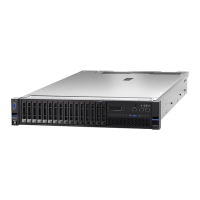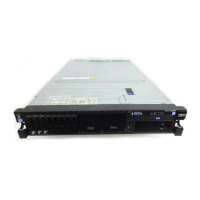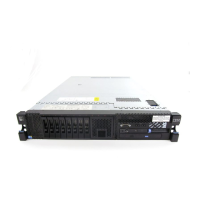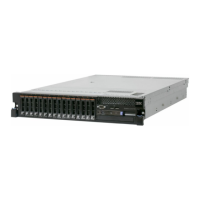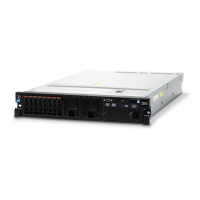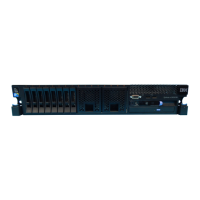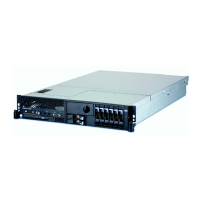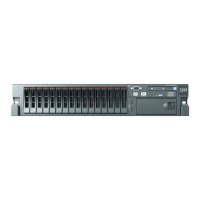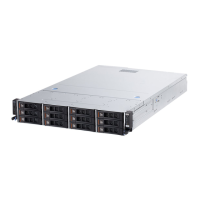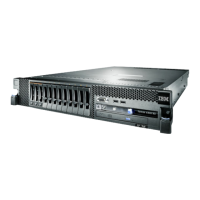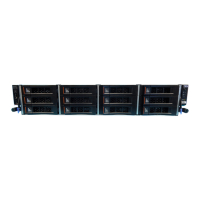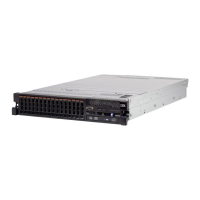A highly available and expandable, rack-dense, 2U dual-socket SMP server, for application
serving in Web environments
Please see the Legal Information section for important notices and information.
6
2-5-inch drives not only require less space than 3.5-inch drives, they weigh less, consume half
the power, produce less noise, seek faster, and offer increased reliability.
(Note: The use of the internal backup drive option precludes the use of two drive bays, limiting
storage to four 3.5-inch HDDs.)
The hot-swap SAS drives use the Converged Tray for interchangeability with other IBM System
x
™
and IBM eServer
™
xSeries
®
systems. If you need more storage space, terabyte capacities
are possible with external direct-attach, NAS and SAN solutions.
Disk/Tape Controllers
All x3650 models include an integrated eight-port Adaptec AIC9580W Serial-Attach SCSI
(SAS) controller. This controller supports up to six or eight (depending on the model) internal
SAS LVD (low-voltage differential) drives, plus external storage via the SAS port on the rear of
the server.
The integrated ServeRAID-8k-l controller offers hardware RAID-0/1/10 support and 32MB of
fast PC2-4200 DDR2 cache for those SAS drives. The ServeRAID-8k option adds three
additional RAID levels, including RAID-1E, 5 and 6, along with 256MB of cache memory for
higher performance, and battery backup, without consuming a valuable adapter slot.
The SAS controller provides data transfer speeds of up to 300MB per second
5
in each direction
(full-duplex) across the SAS bus, for an aggregate speed of 600MBps, nearly double that of
Ultra320 SCSI’s 320MBps (half-duplex) bandwidth. The serial design of the SAS bus allows
maximum performance to be maintained as additional drives are added.
Other supported RAID controllers include:
• ServeRAID-6M — Ultra320, 2-channel, 256MB battery-backed cache, 133MHz PCI-X (2
ports for external SCSI RAID storage)
• ServeRAID-6M — Ultra320, 2-channel, 128MB battery-backed cache, 133MHz PCI-X (2
ports for external SCSI RAID storage)
The ServeRAID-6M controllers support external SCSI expansion via the IBM EXP400 Storage
Expansion Unit.
For external storage, the MegaRAID 8480 controller enables connection to up to four IBM
System Storage EXP3000 SAS expansion units (48 HDDs total). It provides RAID-0/1/10/5/50
support and 256MB of onboard cache. Additional external SAS/SATA storage is available using
the external SAS port on the system unit, or via one of several supported iSCSI or SAN
controllers.
Drive Bays
The x3650 contains either seven or ten drive bays in all, depending on the model. Some
models offer six 3.5-inch bays that support hot-swap SAS or SATA drives. This enables up to
six slimline (1.0") drives totaling up to 1.8TB (SAS) or 6TB (SATA) to be installed.
An internal half-high DDS5 tape drive or GoVault EZ Drive can be installed in place of two of
the HDDs. This offers the confidence of internal tape backup, while still leaving four available
drive bays (for a total disk capacity of up to 1.2TB of SAS or 4TB of SATA storage,
respectively).
Other models feature eight 2.5-inch bays that support hot-swap SAS drives totaling up to
1.17TB. In addition to the eight 2.5" HDD bays, there is a dedicated bay for a half-high DDS5
tape drive or GoVault EZ drive.
A 24X/10X/24X/8X
6
speed (ultraslim, 0.5”) CD-RW/DVD-ROM combo drive with an IDE
interface ships standard in all x3650 servers. No floppy drive is supplied with any model; an
external USB floppy drive may be used, if needed.
For still more storage, a direct-attach, iSCSI, or FC SAN external expansion option can be
added, using an optional controller.
Backup Devices
The x3650 supports several internal and external backup options. Supported drives include:
• 36/72 GB DDS-5 Tape Drive (SCSI)
• 80/120 GB GoVault EZ Drive (SATA)
• 80/160 GB Half High VS160 Tape Drive (SCSI)
• 400/800 GB LTO-3 Ultrium Tape Drive (external SCSI)
5
Data transfer rates depend on many factors and are often less than the maximum possible.
6
Variable read rate. Actual playback speed varies and is often less than the maximum possible.
